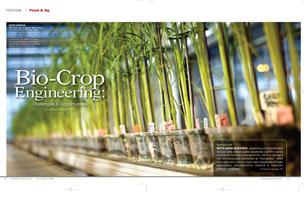
Background
With gene mapping, sequencing and recombination being a reality, venture capital investments and IPO’s started entering the business landscape in the 1990’s to develop a new biotechnological field known as “Transgenics.” While there were new ventures, many were subsidiaries of major agribusiness, pharmaceutical, chemical or consumer products companies.
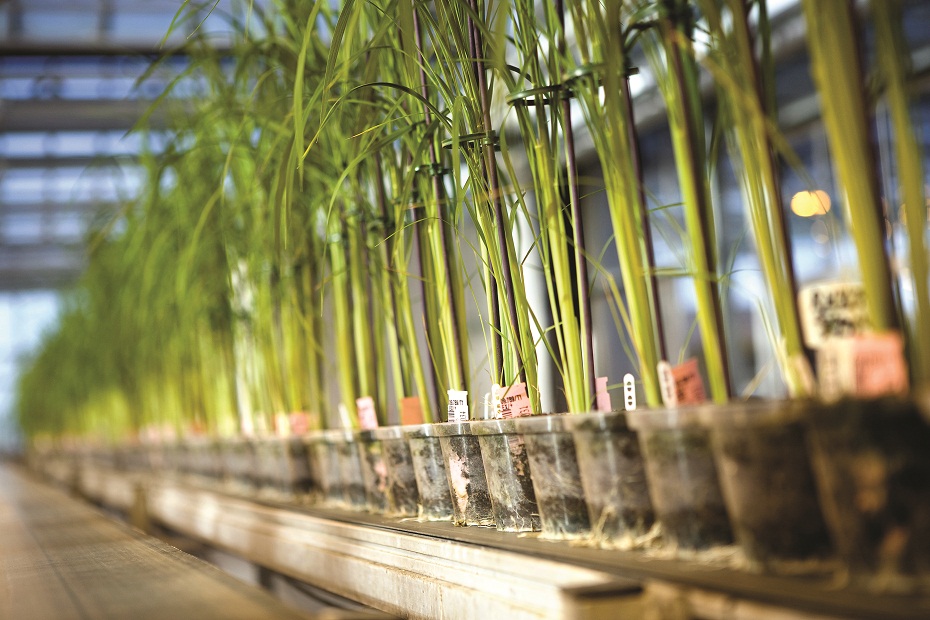 |
| Crop Design - The fine art of gene discovery - Once a week, a conveyor belt transports all the rice plants into a photo chamber, where they are photographed from all sides and underneath by digital cameras. The resulting data are stored in a dedicated database, enabling researchers to monitor the development of the genetically modified plants. |
Driven by its low cost, growing plants to produce a wide range of specialty proteins the concept of a “living factory” was seen as a viable and profitable industry. The incorporation of regulatory genes that control the target protein generation has given biotechnologists the ability to fine-tune the production of specific proteins within a carrier protein. This process, known as specialty gene production, has had revolutionary economic and bio-technological implications.
Early Projections
The initial prospects for Mid-west farmers and their communities to move from commodity- based production toward a new production technology was considered to have multiple economic benefits. Among them were:
• The ability to retain ownership of family farms
• Maintenance of the cultural link between farming and the local community
• Creation of a new economic driver that brings high-wage, skilled employment
• Location of “bio-refineries” in area that have lost traditional manufacturing facilities and jobs
• The low cost for adapting new identity-preserved production systems with minimal disruption to current systems
Commercially, plant-based production has significant potential implications for many industries. A recent study conducted by Iowa State University found that “this is particularly true for pharmaceutical production. ‘Pharming’ is the term being applied to Plant Manufactured Pharmaceutical (PMP) crop technology. If a protein, for example, a human antibiotic, is derived from animal sources, the expense, severe production limitations, and ethical dilemmas of that production system could become moot points. Instead of being able to produce a few hundred very costly liters of a rare vaccine, a company could manufacture quantities limited only by the acres available for production. Additionally, the product-isolation techniques could be far less quality control intensive, and far less expensive. Even administering the final product may be simplified. Instead of injecting a child with a vaccine, one could just give him or her, for example, a confectionary product for oral consumption that contains the protein.”
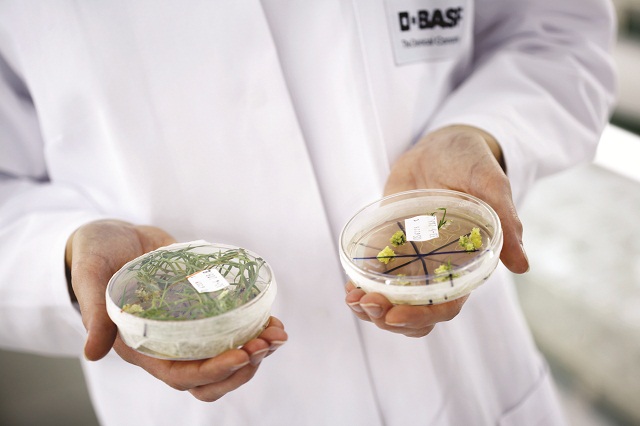 |
| Petri dishes with genetically modified rice plants in various stages of growth. During the first few weeks, cell clusters (so-called calli) develop from the seeds which then grow into seedlings. |
Risks & Liabilities
Regardless of the anticipated benefits of “pharming” there have been events that have brought into question several significant concerns relative to bio-farming. One primary concern is that of the potential risks and liabilities associated with accidental commingling with the food supply.
One of the most notable incidents of potential commingling occurred in Nebraska during 2002. In that incident, APHIS (Agriculture Animal and Plant Health Inspection Service) inspectors discovered "pharmaceutical" volunteer corn growing in a soybean field. The corn was from the previous year, when the firm Prodigene had tested a pharmaceutical corn to produce a swine vaccine.
As a result, both the harvested soybeans (500 bushels) and the entire soybean load of 500,000 bushels in local elevator were quarantined. In another accident in Iowa, the USDA forced Prodigene to burn 155 acres of conventional corn that may have cross-pollinated with some of the company's pharmaceutical plants. In both cases, the infraction was viewed to come from Prodigene's failure to adhere to permit protocols issued by APHIS. Prodigene was fined US$250,000 and required to pay approximately $3 million for the cleanup costs and disposal of contaminated corn and soybeans.
Current Status
It is important to recognize that genetically engineered crops grown to produce PMPs have little in common with traditional agriculture. Further, despite early hopes, these pharmaceutical crops do not represent a new wave of value-added agriculture. Instead, they represent a component of pharmaceutical and industrial enzyme manufacturing process. Their cultivation in the field is predicated on the requirement of total isolation and confinement from the food supply.
The economics and cost structure of growing pharmaceutical crops is determined by several factors, chief of which is risk minimization. This process requires:
• A sophisticated risk management to avoid potential gene outflow and minimize impact on non-target organisms, as well as workers' health
• Establishment and close monitoring of a tight closed-loop system to avoid any possibility of commingling with food supply
• Quality-control, isolation and confinement protocols designed to meet rigid Agriculture Animal and Plant Health Inspection Service requirements
The United States Department of Agriculture’s Animal and Plant Health Inspection Service (USDA APHIS) have instituted a strict permitting process for genetically engineered pharmaceutical-producing crops.
Under the permitting process, APHIS reviews all plans for seed production, timing of pollination, harvest, crop destruction, shipment, confinement, and the storage and use of equipment. Field inspections may take place up to five times during the growing season coinciding with critical times of production. APHIS issues a field test permit either to an individual company or research institution who, in turn, may subcontract with growers. Subcontracting farmers are also required to undergo training in permit requirements and implementation.
The FDA also regulates human drug and biological products produced from pharmaceutical plants. The FDA considers pharmaceutical crops to be outdoor manufacture sites and subject to regulatory scrutiny similar to that applied to conventional drug manufacturing facilities.
In short, the FDA's responsibility extends to the entire manufacture of the biopharmaceuticals—from production to waste streams. Therefore, its role necessarily complements and overlaps the role of APHIS at the field production stage.
While APHIS regulates the growing and isolation of engineered crops, the FDA regulates materials, equipment, and manufacturing processes, encompassing everything from seed stock to packaging. The rules under which production and packaging take place are always changing.
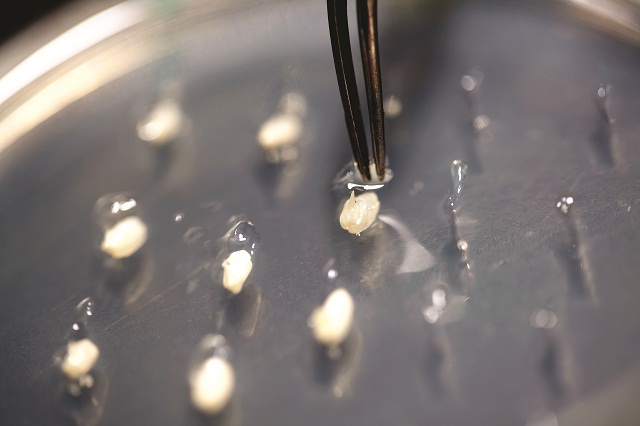 |
| Selected plant genes are transported into rice seeds. This process, also known as transformation, is assisted by agrobacteria, which are capable of transporting individual genes into a plant’s genetic information. |
Bio-pharming and the Food Industry
The quick discovery and resolution of the Prodigene incident was credited to the effectiveness of the existing regulations and oversight. The incidents themselves provided the industry with a precedent for what could happen in the future, as more pharmaceutical crops are grown in open fields.
In the medium and long-term, evolving confinement processes may require new and innovative responses from the biotechnology industry itself. Confinement trends currently being evaluated include production strategies that combine both greenhouses and confined facilities with open fields. Other firms use plants in completely closed facilities or greenhouses.
Technological Solutions and Environmental Impact
There are also potential environmental risks as the result of pharmaceutical crops. Included are:
• Potential safety issues linked to contamination with residual pesticides, herbicides, and toxic plant metabolites
• Altered plant contaminating wild strains, and human exposure to plant material containing potent drugs
• Concern that transgenes will spread in the environment and affect non-target organisms
Because many biopharmaceuticals are proteins with little or no biological activity when ingested (e.g., vaccines and antibodies), it should be noted, that not all may be harmful; and many may be considered benign to non-target organisms.
Moreover, most proteins are digestible and may pose little hazard of toxicity. Nevertheless, biopharmaceuticals may be toxic in higher doses (e.g., anticoagulants, hormones, and enzymes) and/or may persist longer in the environment (as in the case of lipophilic drugs).
To limit environmental exposure, several technological solutions are being pursued, such as:
• Inducing genes to produce therapeutic proteins only after harvest. For example, to induce production of the protein glucocerebrosidase, LSBC uses a non-transgenic tobacco plant cut at a given height and sprayed under confined conditions with recombinant plant virus
• Spraying tobacco plants in the field, harvesting a few days later, and then purifying the protein (Zavon & Flinn, 2003)
• The use of chloroplast transformation to limit gene flow. This approach consists of introducing the gene not in the plant genome, per se but rather, in chloroplast DNA, which enables the plant to produce the target protein but is not transmitted to the seed. This is the same approach followed by Chlorogen for tobacco
• Using plant genomes that are incompatible with nearby related species
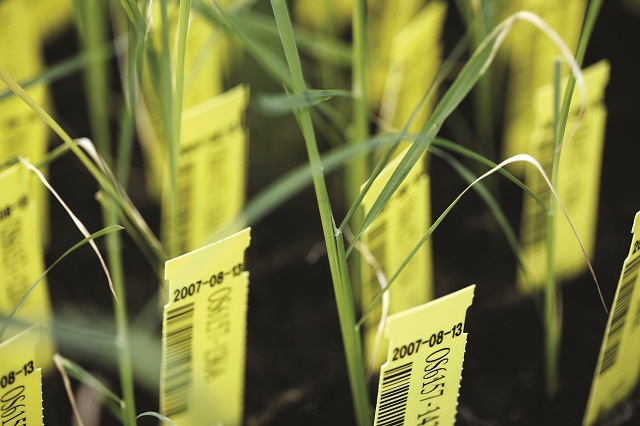 |
| Each genetically modified rice plant in the greenhouses at CropDesign has a barcode and transponder, allowing it to be accurately identified at any time. The rice plants ripen in the greenhouse until they are harvested - some of them under ideal conditions. Copyright by BASF |
Obstacles
Pharmaceuticals from plants represent a major game change in the continual development and ongoing biotechnology revolution. Yet there is a question as to their inevitability.
It is clear that the cheaper production and capital costs of pharma crops, as well as their greater production flexibility, give them a strong appeal as bio-factories for drug development. However, there are many scientific, regulatory, and economic hurdles that remain to be overcome.
First, PMPs, as a new concept, must fully demonstrate "proof of concept;" the suitability of green plants for protein manufacture is still not fully resolved. The economics clearly present a convincing scenario. The trends offer a compelling picture and, so far, point toward feasibility.
The fact remains that until these are approved by the FDA for commercial use, there is still a large segment within the drug industry not yet convinced that plant proteins will be as effective as animal-based proteins.
Second, new technological developments may or may not continue to favor open-field cultivation compared to confined greenhouse production.
A third factor is that the cost advantage of PMPs could change in favor of other production platforms with technological improvements in fermentation processing or with animal-based transgenics (such as the use of milk glands as the production medium).
In the final analysis, plants need to be viewed as just one of many possibilities for manufacturing therapeutic proteins.
PMPs could evolve along several paths. They could either dominate specific therapeutic protein markets or monopolize biogenerics. Overall, plant transgenics will likely be the favorite expression system with proteins that do not express well in traditional systems, are given in large doses, or for which production costs make them too expensive to bring to market.
Pharmaceutical crops may not require large amounts of acreage. The area needed will depend on the potential demand for the pharmaceutical products. For example, the production of the antibody against bacteria that cause tooth decay would require 600 kilograms per year, which can be supplied by a single large tobacco farm. On the other hand, using tobacco to produce human serum albumin may require up to 45,000 acres of tobacco to meet world demand.
The ongoing challenge for pharma crops grown in open-field conditions in proximity to food crops is of ensuring 100% containment. This is a daunting task. As a result, there is an expectation that there will be significant spillover effects on food-crop markets, in the likelihood of contamination. This is particularly true if PMPs are expressed via food crops such as corn or rice.
Once the current cycle of product development reaches the commercialization stage for the biotech and drug industry, biopharming could offer tremendous economic and health benefits.
Regardless of the scope of these benefits, the central issue remains that of risk to the food industry and the environment. Industrial and agricultural investments in biopharming must weigh the size of economic payoffs from growing pharmaceuticals against the costs and liabilities within the food supply system, including the potential loss to export markets.
A combination of strong and adaptable regulatory oversight with technological solutions are required if the twin goals of realizing the full potential of biopharming and safeguarding the food system and the environment are to be met.

